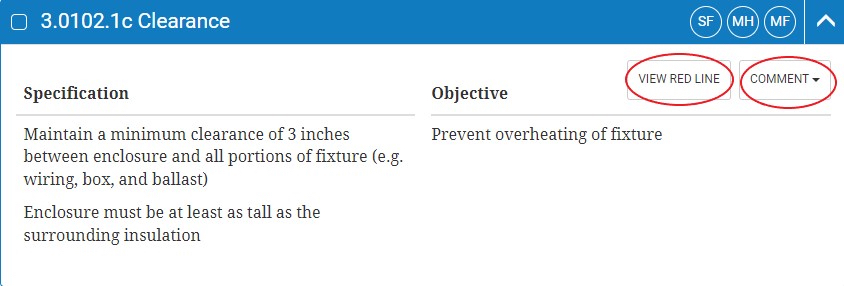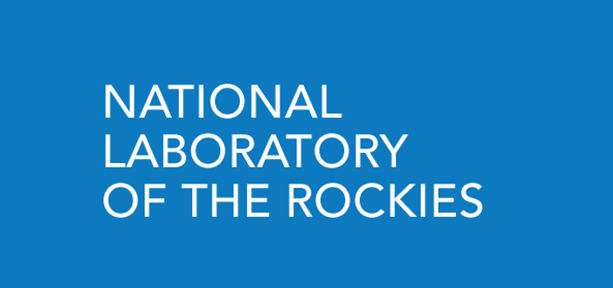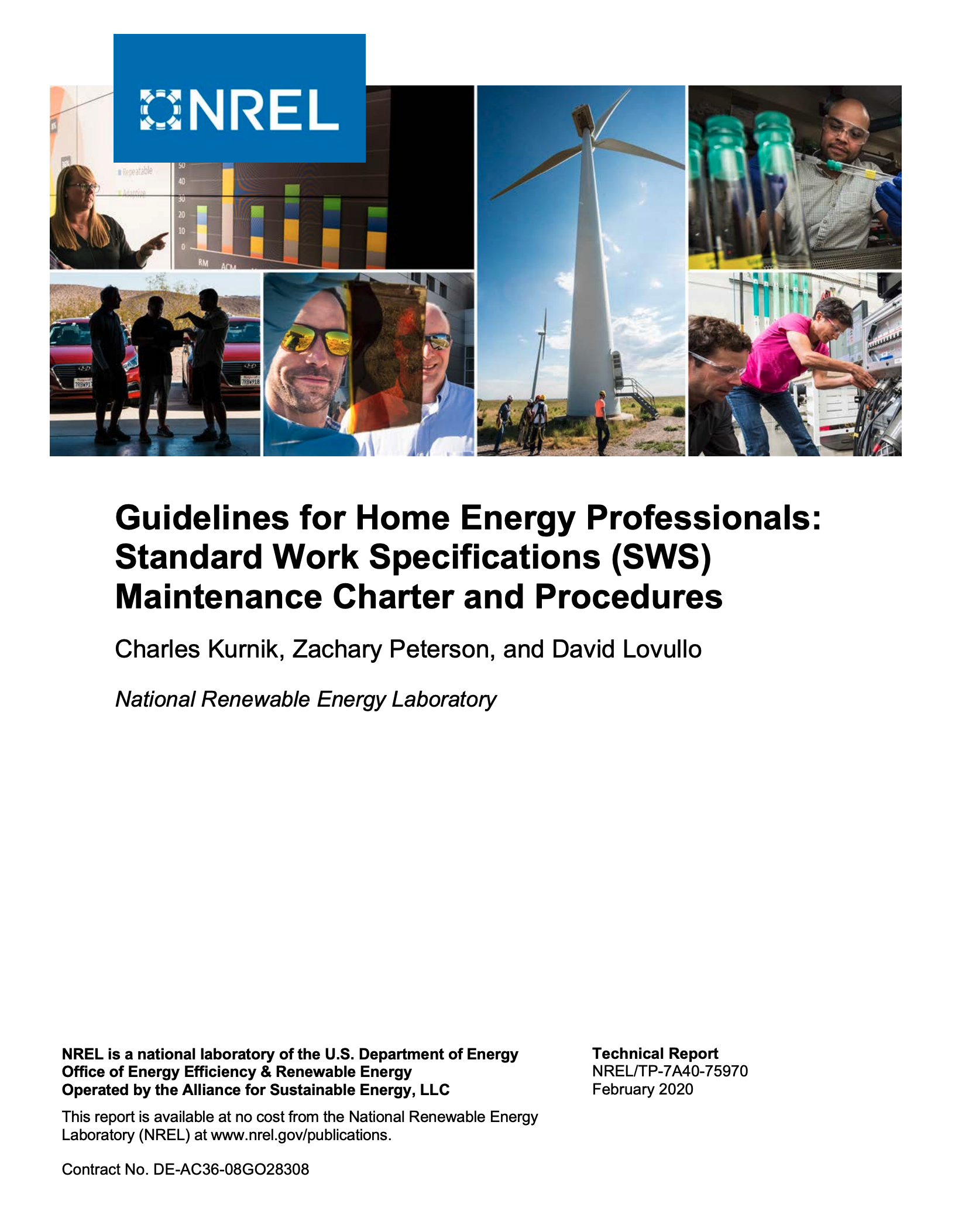The Standard Work Specifications (SWS) are maintained to ensure they continue to reflect industry-accepted practices. Industry stakeholders are encouraged to suggest revisions to the SWS by submitting comments. The SWS maintenance committees review these comments to determine if/how the SWS should be updated.
Maintenance Charter and Procedures
Read NREL’s report to learn all about the SWS:
- Maintenance framework
- Maintenance procedures
- Committee membership
- Subcommittee meetings
- Executive committee meetings
- Maintenance ranking criteria.
Five-Year Maintenance Cycle
The SWS are updated according to a five-year maintenance cycle. To learn more about the maintenance cycle, see the SWS Maintenance Charter and Procedures.
The table below shows the maintenance schedule and plan by fiscal year (FY).
FY 2021─2025 Maintenance Schedule and Plan
| FY 2021 | FY 2022 | FY 2023 | FY 2024 | FY 2025 | |
|---|---|---|---|---|---|
| 2020 Update | Open for comment | Q1-Q3: Open for comment Q4: Comment deadline | |||
| 2023 Redline | Q1-Q3: 2020 Q4: Redline Published | Q1-Q3: Redline open for Comment Q4: Deadline for Redline comments | |||
| 2025 Update | Q1-Q3: Redline comments reviewed/ adjudicated Q4: 2025 Update published |
2023 Maintenance Event Summary
The 2020 SWS revisions reflect significant updates from the 2017 version along with an improved SWS online tool allowing stakeholder feedback by adding comments directly from the online tool. These updates along with the improved online tool, provide a more consistent framework for future additions to ensure updates align with the original intent, existing standards, and format of the SWS.
2020 SWS changes are based on methodology which confirmed the relevance and applicability of existing content while removing duplicative details across housing types. Any specifications that dictate building analysis practices, safety practices, or measure selection were removed as these items do not align with the intent of the SWS. Most occupant education specifications were removed along with specifications that would be difficult to verify at a final inspection site. Updates to the SWS also prioritized removing specifications that simply referenced outside standards but provided no actual installation details. If a referenced standard met the intent of the SWS, language from that standard was added instead of requiring the user to look elsewhere, which often involved an additional cost.
The updates described above reduced the volume of specifications by 50% without losing relevant information, while improving the organizational structure and ease of use.
SWS Maintenance Committees
The entity that evaluates and approves updates is composed of an executive committee and three subcommittees, which includes a subject-matter expert for individual SWS sections.
The subcommittees are the working groups that adjudicate comments received in the comment review period prior to the SWS maintenance event. To learn more about the specific procedures of the maintenance committees, see the SWS Maintenance Charter and Procedures.
Interim Updates to the SWS
While most comments will be addressed at regular Maintenance Committee meetings, comments meeting specific criteria may be addressed on an interim basis. To quality for an interim update, the comment must meet one of the following criteria:
- Represents a major life-safety or health issue
- Submitted on behalf of a major industry organization.
Comments that meet the criteria will be addressed by a DOE WAP representative, a National Renewable Energy Laboratory expert, and at least one subject matter expert from the Maintenance Committee.
Maintenance Redline Language and Updates
Prior to releasing an updated version of the SWS or introducing new specifications, the proposed changes and additions are released in redline form. This allows stakeholders time to review and respond to the redline language before it is fully accepted into the SWS. See above table for the current maintenance schedule and plan. To learn more about the updates and redline reports, see the SWS Maintenance Charter and Procedures.
Redline Reports and Comment
During the current 5-year adjudication cycle, public comments were gathered on the 2020 update during FY2021 and FY2022 (Years 1 and 2). In the third year, the Committee deliberates on these comments, deciding which ones are accepted, accepted with modifications, or rejected – providing a rationale for each decision and generates a draft redline draft with such edits. A total of 56 comments have been adjudicated through the Committee review process of comments received from August 2020 through October 2022. You can view the list of specifications with redline changes here.
The 2023 SWS Maintenance documents track all comments and proposed new specifications to the SWS while allowing stakeholders a method to view comments, changes, and the rationale behind them. Stakeholders are encouraged to provide feedback on the proposed changes directly in the online SWS tool. The redline version is open for public comment through September 30, 2024.
After the public comment period for the 2023 redline version ends, the SWS Committees will once again adjudicate comments and by Year 5, the culmination of this process will result in redline updates going live and the SWS will be updated, concluding the current 5-year maintenance cycle.
How to View and Comment on 2023 Redline Changes:
To view the redline version of an adjudicated comment, click on “View Red Line”. To provide feedback on redline versions and/or the New Draft Specifications, click on the “Comment” tab. For more information on how to navigate the SWS site, visit https://sws.nrel.gov/help.

2023 Draft New Specifications Spreadsheet
2023 Redline Report (with tracked changes)
For reference, see the archives below.
The U.S. Department of Energy suspended the 2018 and 2019 SWS redline report to streamlined the release of the FY 2020 SWS full update and created a structured approach for additions or changes to the SWS in the future.
The maintenance event happened during the summer of 2020 to revise the SWS based on the design principles in the SWS design document. Watch this introductory video for more information. Also users can download the 2020 Update Change Log to track the transition of each specification from the 2017 SWS to 2020 SWS.
The SWS have been updated to SWS Version 2017 (SWS v.2017). SWS v.2017 is the first major update to the SWS and reflects all adjudication efforts since the launch of the SWS Online Tool in 2014. In March 2017, the SWS subcommittee reviewed and adjudicated 141 comments that were received prior to Jan. 25, 2017. (This in-person meeting was held in conjunction with the 2017 HPC National Home Performance Conference in Nashville, TN and was open to the public.) These updates, along with previous redline updates in 2016 and 2016 were incorporated into the SWS v.2017. A total of 288 comments have been adjudicated through the committee process since its inception.
Additionally, the SWS executive committee and the NREL technical team performance a crosswalk of all housing types in the entire Health and Safety section, accounting for 308 specifications. This task was undertaken to address inconsistencies within the different housing types in this section. The updated SWS v.2017 reflects all prior adjudications and crosswalk changes, which includes language and numbering changes.
Please note: The SWS v.2017 may have altered your existing weatherization field guide. WAP Grantees should review and update field guides accordingly, prior to submitting to DOE.
The 2017 SWS Maintenance documents track all changes made to the SWS, leading to the SWS v.2017. The 2017 Master Key document lists all specification that have been altered (either with a number change and/or a language change) and will be useful for updating field guides. The 2017 SWS Comment Spreadsheet shows all adjudication comments and proposed language from the 2017 in-person meeting in Nashville, TN. The 2017 SWS Health and Safety Crosswalk shows all number and language changes to the Health and Safety section. The 2014 SWS archives provide a reference of each housing type, prior to the 2017 updates.
2017 SWS Health and Safety Crosswalk
For a reference of each housing type, see the 2014 archives below.
A total of 94 comments received prior to October 31, 2015 were reviewed and adjudicated by the following committees: Health & Safety Committee, HVAC & Baseload, and Air Sealing & Infiltration. The resulting updates are displayed in the 2016 SWS Redline documents below, which also contain all updates made during the 2015 Combustion Safety Maintenance Update. The 2016 SWS Comment Spreadsheet details the specific comments and adjudication responses.
The changes represented in the redline versions and comment spreadsheet are intended to be integrated into the SWS Online Tool by October 2017. Redline documents can be used as a reference by users who are looking for the most up-to-date industry standards.
Please note: At this time, WAP grantees are NOT required to revise their field guides in accordance with the redline documents.
The 2016 SWS Redline documents and comment spreadsheet can be found below.
2016 Redline Report (with tracked changes)
Comments received on Section 2.02: Combustion Safety of the SWS prior to July 1, 2015 were reviewed by the Health & Safety Committee on August 8, 2015 to reach consensus and align the SWS with industry standards, such as the ANSI/BPI-1200-S-2015 Standard Practice for Basic Analysis of Buildings, recently released by the Building Performance Institute, Inc. (BPI). The committee reviewed 44 comments and performed a crosswalk of the entire 2.02: Combustion Safety section to make updates and align the standards. Updates were also made to Details 5.3003.14 & 15: Heating & Cooling – Forced Air, to align these Details with BPI-1200. The comments were adjudicated and the committee provided feedback for their actions. A redline version of this section was created for future integration into the SWS Online Tool.
Redline documents can be used as reference by users who are looking for the most up-to-date industry standards. Please note: At this time, WAP grantees are not required to revise their field guides in accordance with the redline documents.
The 2015 Combustion Safety comment spreadsheet can be found below. In order to facilitate a better user experience, the 2015 SWS Combustion Safety Redline documents were combined with the 2016 SWS Redline documents above.
The first-ever SWS Maintenance Committee meetings were held on Monday, April 28, 2014 in Detroit, MI, which preceded the 2014 ACI National Home Performance Conference. 22 subject matter experts, split amongst 4 technical sub-committees, reviewed 185 comments that were submitted prior to the event. On Friday, May 2, 2014, an Executive Committee meeting was held with all committee chairs to resolve any crosscutting issues and all comments flagged for further discussion.
The resulting documents from this event can be found below.
Housing Types
2014 Archive SWS Single-Family Home

